Apache Campaign (1896)

Apache scouts following Massai's trail, by Frederic Remington, 1898.
|
|
| Date | April - June 1896 |
|---|---|
| Location | United States, Mexico |
| Outcome | 2 killed 1 wounded 2 captured |
The Apache Campaign of 1896 was the final United States Army operation against Apache renegades. It began in April after some Apaches killed three American settlers in Arizona. The renegades were pursued by the army, which caught up with the hostiles in the Four Corners region of Arizona, New Mexico, Sonora and Chihuahua. There were only two important encounters during the campaign and, because both of them occurred in the remote Four Corners region, it is unknown if they took place on American or Mexican soil.
Though the Apache Wars ended at Skeleton Canyon, Arizona in September 1886, when Geronimo surrendered, small bands of Chiricahuas continued to fight against the United States and Mexico from their strongholds in the Sierra Madre. There were two well known renegades at this time, the Apache Kid and Massai, both former Indian scouts that had served on opposing sides during Geronimo's War. The Apache Kid became a renegade in 1887, but he surrendered to the army in June of the same year and remained within the legal system until November 1889, when he escaped police custody during an incident known as the Kelvin Grade Massacre. Massai had been on the run since 1882, when he heard of the Apache exodus from San Carlos. After Geronimo's surrender, Massai became famous for escaping the army in Missouri, while traveling on a train to Florida with other Apache prisoners. Massai then found his way back to Arizona alone and on foot. Contemporary accounts say that Massai and the Apache Kid occasionally cooperated with each other during their time as renegades and that most of Massai's raids into the United States may have been attributed to the Kid. According to an article by Britt W. Wilson, in the October 2001 issue of Wild West, by the mid-1890s, hostile Apache activity in southern Arizona increased.
...
Wikipedia
